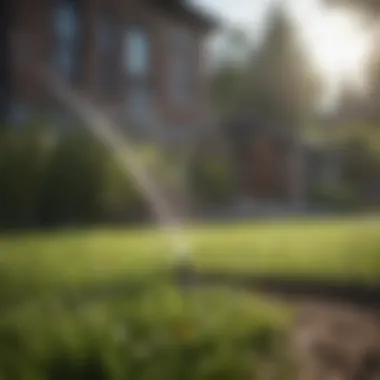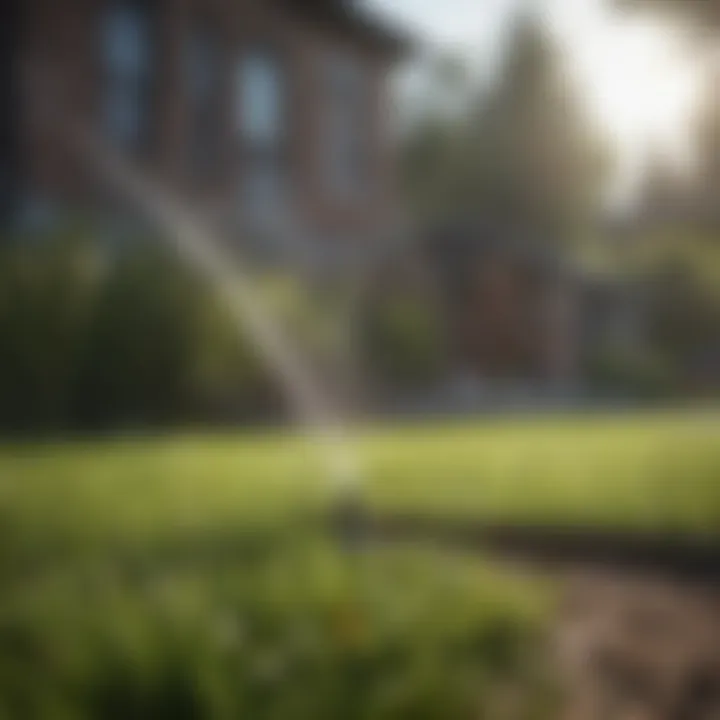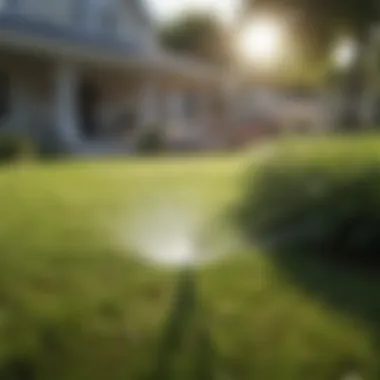Effective Lawn Irrigation Post-Fertilization Tips


Intro
Proper watering after fertilization is a critical aspect of lawn care. It can determine how effectively the nutrients from the fertilizer are absorbed by the grass. Understanding the right timing and techniques for irrigation can significantly enhance the health and appearance of your lawn. This guide delves into these practices, offering valuable insights for homeowners and gardening enthusiasts alike.
Effective irrigation isn't a one-size-fits-all solution. Environmental factors such as soil type, climate, and the specific type of fertilizer used all play a significant role in how your lawn responds after fertilization. Without careful attention to these aspects, the results may not meet expectations, leading to wasted resources and effort.
Learning how and when to irrigate optimally ensures the added nutrients positively contribute to the lushness of your lawn. The following sections will explore various dimensions of lawn irrigation post-fertilization, highlighting essential techniques and considerations.
Prelude to Lawn Fertilization
Lawn fertilization is a crucial aspect of maintaining a healthy and vibrant lawn. It goes beyond just aesthetics; it plays a significant role in soil health and grass vitality. Proper fertilization helps in replenishing nutrients that grass needs to grow, thus ensuring that it remains lush and resistant to pests and diseases. This article will explore the reasoning behind fertilization and the types available, providing valuable insights into optimizing your lawn care.
Purpose of Fertilization
The primary aim of lawn fertilization is to improve the overall health of the grass. Fertilizers provide essential nutrients like nitrogen, phosphorus, and potassium. These nutrients contribute to various physiological functions within the grass. For instance, nitrogen promotes lush, green growth, while phosphorus supports root development. Potassium enhances drought resistance and helps the plant in stress recovery. Thus, applying the right fertilizer at the correct time can lead to a more robust lawn.
Additionally, fertilization can improve soil structure. Healthy soil retains moisture better and allows for proper drainage. Fertilizers can also stimulate microbial activity in the soil, which is vital for nutrient breakdown and absorption. Therefore, the purpose of fertilization transcends just feeding the grass; it cultivates a healthier ecosystem beneath the surface.
Types of Lawn Fertilizers
Several types of lawn fertilizers exist, each serving different purposes and containing various nutrient ratios. These include:
- Granular Fertilizers: These are the most commonly used fertilizers. They are made in pellet form and can be broadcast over the lawn. They release nutrients slowly, providing an extended feeding period for the grass.
- Liquid Fertilizers: Typically easier to apply, liquid fertilizers offer immediate nutrient availability to the grass. They are absorbed quickly and can be beneficial for quick repairs after damaging events.
- Organic Fertilizers: These fertilizers are derived from natural sources, such as compost or manure. They improve soil quality over time and are less likely to cause fertilizer burn. Their nutrient release timing is generally slower and more sustainable.
- Synthetic Fertilizers: These are chemically manufactured and often provide precise nutrient ratios. Although they can lead to rapid grass growth, they also carry a risk of leaching and potential burn if not applied correctly.
Selecting the appropriate type of fertilizer is essential for successful lawn care. Its effectiveness depends on the specific needs of the grass, the soil's nutrient profile, and the climate conditions.
"Fertilization is not just about growth, it is about understanding the needs of your lawn and how best to support it."
Importance of Proper Watering After Fertilization
After applying fertilizer, watering your lawn is crucial. The right amount of water can make a significant difference in how well your lawn responds to fertilizers. Improper watering can lead to a variety of problems that affect the health and appearance of your grass.
Nutrient Absorption
Watering post-fertilization promotes optimal nutrient absorption. Fertilizer contains essential nutrients, such as nitrogen, phosphorus, and potassium. These nutrients need moisture in the soil to dissolve and become available for grass roots. Without adequate water, your fertilizer may sit atop the soil, unable to reach the roots.
Watering helps draw these nutrients into the soil. Properly hydrated soil allows nutrients to leach down, making them accessible to the grass. The appropriate depth of water is typically around six inches, ensuring nutrients can penetrate the root zone. It is important that the watering takes place soon after fertilization. If you wait too long, the nutrients might evaporate or wash away.
Prevention of Fertilizer Burn
Another key advantage of correct watering is the prevention of fertilizer burn. Fertilizer burn occurs when high concentrations of salts in fertilizer damage the grass. This can lead to brown patches, wilting, or even death of turf grass. Watering immediately after applying fertilizer dilutes these salts, reducing their concentration.
It is advisable to water lightly but sufficiently right after fertilization. The goal is to moisten the soil, not saturate it. A light watering can mitigate the risk of harm. However, over-watering can create a different set of issues, such as waterlogged soil and root rot. Finding balance is important. Therefore, assessing your soil type and current weather conditions can tailor your watering approach effectively.
Timing for Watering
The timing of watering after fertilization is crucial for maximizing the benefits of the fertilizer applied. Watering appropriately can directly influence nutrient absorption and help prevent potential damage such as fertilizer burn. Attending to the timing aspect means understanding when to introduce moisture to the soil and how it can affect the grass's growth.
Immediate Watering Post-Fertilization


Watering your lawn immediately after applying fertilizer can be beneficial in some cases. This method serves to activate the fertilizer, allowing nutrients to dissolve and penetrate the soil. The immediate watering helps in reducing the risk of the fertilizer crystallizing on the grass surface, which can cause burning if left unattended.
Furthermore, this practice helps to wash the tiny granules into the soil, ensuring that the grass roots have direct access to the nutrients. Homeowners often observe that, when fertilizing during the warmer months, an immediate watering boost can kick-start the lawn’s growth cycle.
However, it is essential to consider the type of fertilizer used. Slow-release fertilizers, for instance, may require a different approach. In these cases, watering right after application might not be necessary and could sometimes wash away essential nutrients. It’s important to read the instructions on the specific fertilizer to ensure you follow the proper watering guidelines.
Waiting Period Recommendations
Conversely, waiting a specific period post-fertilization also has its advantages. Many experts recommend a waiting time of about 24 to 48 hours before watering. This delay allows the fertilizer to settle and start working into the soil naturally. It gives the soil time to absorb the nutrients without the influence of overwatering.
Taking a moment to monitor the lawn conditions is vital before deciding to water. Consider factors such as humidity and temperature. For example:
- High Humidity: If the environment is humid, soil moisture may maintain longer, requiring less immediate watering.
- High Temperature: In contrast, high heat requires prompt action to prevent drying out the grass and ensure nutrient activation.
Moreover, the recommendation to wait can prevent the potential loss of nutrients from leaching away due to excessive watering. Overdoing irrigation too soon can dilute the fertilizer, rendering it less effective.
In summary, the timing of watering post-fertilization is not a one-size-fits-all strategy. Homeowners are advised to evaluate their unique lawn conditions, ranging from the type of fertilizer used to the current weather patterns and soil type. Achieving a balance enables you to cultivate a healthier and more vibrant lawn.
"The proper timing for watering can be as crucial as the fertilizer type itself for the best lawn performance."
Understanding when to water allows for stronger grass and better overall lawn health.
Factors Influencing Watering Duration
Understanding the various factors that influence watering duration is crucial in optimizing the health of your lawn after fertilization. This section elaborates on specific elements such as soil type, grass types, and climate conditions which can significantly impact how much and how often you should water.
Soil Type Considerations
Soil type plays a fundamental role in determining watering duration. Different soil textures retain moisture uniquely. For example, sandy soils drain quickly and require frequent watering, while clay soils hold water much longer.
- Sand Soil: Sandy soil can dry out rapidly. Watering techniques should involve shorter, more frequent sessions to keep nutrients dissolved in the soil, rather than lost to evaporation.
- Clay Soil: Conversely, if your lawn has clay soil, watering should be less frequent but deeper. This approach ensures that the water penetrates adequately, promoting deeper root systems.
- Loamy Soil: This is often ideal for lawns, holding moisture well while allowing drainage. Watering might require a moderate approach here, perhaps once or twice a week.
Grass Type Variations
The type of grass will also dictate watering needs and duration. Different varieties of grass have distinct tolerances to drought and moisture. Cool-season grasses, such as Kentucky bluegrass, generally thrive better in spring or fall and need less water during the heat of summer.
- Cool-Season Grasses: Require around one inch of water per week, spread throughout the week. Their peak growth occurs during cooler temperatures.
- Warm-Season Grasses: These types like Bermuda grass or Zoysia grass are typically more heat resistant and may require about 1 to 1.5 inches of water in the hottest months.
Recognizing grass types will help in scheduling and factoring the duration of watering. Generally, deeper watering less frequently is preferable for most grass types.
Climate Conditions
Finally, climate conditions greatly influence how long you should water your lawn. Temperature and humidity affect evaporation rates, which can lead to different watering durations.
- Hot and Dry Climates: Areas with high temperatures and low humidity may necessitate more frequent watering, possibly every few days, depending on soil type and grass type. In such conditions, a morning irrigation schedule helps minimize evaporation losses.
- Wet and Humid Climates: Conversely, if you live in a region with high humidity or seasonal rainfall, your watering frequency can be significantly reduced. Monitor natural rainfall and adjust your irrigation schedule, as too much water could lead to issues like root rot.
By evaluating these factors - soil type, grass variations, and climate conditions, you can refine your watering strategy for optimal lawn health after fertilization. Adjustments based on these metrics create a more sustainable approach and enhance the effectiveness of your fertilization efforts.
Techniques for Effective Watering
Effective watering techniques are essential for maintaining a healthy lawn after fertilization. The right approach ensures that nutrients are absorbed efficiently, helping the grass thrive. An effective watering strategy does not only support lawn health but also conserves water, making it environmentally friendly. Understanding various watering methods can empower homeowners to make informed choices that enhance their lawn care practices.


Irrigation Systems Overview
Irrigation systems can make a significant difference in how efficiently your lawn receives water post-fertilization. The most common types include:
- Sprinkler Systems: These systems can be stationary or oscillating, providing even coverage, conducive for medium to large lawns. They can be adjusted for frequency and duration, making them versatile.
- Drip Irrigation: This method delivers water directly to the roots of plants. Though less common for entire lawns, it is beneficial for flower beds or garden areas needing precise watering.
- Soaker Hoses: These hoses allow water to seep through the walls. They are particularly useful for smaller areas, ensuring soil moisture evenly.
Different systems offer tailored solutions based on lawn size and type. Properly using these systems can enhance nutrient uptake and reduce waste.
Manual Watering Best Practices
Manual watering is another viable option that some homeowners prefer. This method allows for direct control over the amount of water applied. However, it requires diligence to avoid under or over-watering. Here are some best practices for manual watering:
- Water Slowly: Apply water at a low pressure to avoid runoff and ensure deeper penetration into the soil.
- Watch the Weather: Avoid watering during rainfall. An adjustment prevents unnecessary water use and protects your lawn.
- Early Morning Routine: Watering early helps reduce evaporation losses due to warmer temperatures later in the day. It also minimizes the risk of fungal diseases.
Being mindful of when and how much to water can lead to a more resilient lawn and healthier plant life overall.
Using Sprinklers Efficiently
To maximize the benefits of sprinkler systems, certain efficiencies should be considered:
- Set a Timer: Timers help regulate watering times. This technique not only conserves water but also avoids over-saturation.
- Adjust for Wind: Wind can disperse water unpredictably. Adjust the direction and time of watering accordingly to ensure all areas of the lawn are covered.
- Use a Rain Gauge: A rain gauge helps track rainfall, ensuring that additional watering is done only when necessary. This tool can prevent overwatering and related issues.
Signs of Over-Watering or Under-Watering
Understanding the signs of over-watering or under-watering is crucial in ensuring the health of your lawn after applying fertilizer. Both scenarios can negatively impact the effectiveness of fertilization, leading to potential harm to your grass. Over-watering can wash away the nutrients, while under-watering can hinder nutrient absorption. Recognizing these signs allows for more effective lawn care practices, enhancing the overall appearance and viability of your green space.
Recognizing Over-Watering Indicators
Over-watering is often characterized by a few key signs. First, consider the overall appearance of your grass. Signs of excessive moisture include:
- Yellow or discolored patches: Healthy grass typically maintains a vibrant green color. If patches start to turn yellow or brown, it might suggest water saturation.
- Soggy soil: If the topsoil feels overly moist, it can indicate too much water retention. Walk around the lawn and feel the dirt; if it sticks to your shoes, it’s a clear sign.
- Sparse growth: Grass that becomes weak or refuses to grow properly reflects that it might be drowning from constant water.
- Fungal growth: Overly wet conditions create a perfect environment for fungi. Frequent appearances of mushrooms in your lawn can point towards excessive watering.
These indicators can help you quickly determine if you need to adjust your watering schedule.
Identifying Under-Watering Symptoms
On the other hand, under-watering presents its own challenges. Not providing enough moisture can lead to several adverse effects on your lawn. Look for these symptoms:
- Brown or crispy grass blades: If grass turns brown and feels dry to the touch, it suggests a lack of water.
- Wilting grass: Grass that doesn't stand upright can indicate severe moisture deficit. This happens when the plant cannot retain enough water.
- Footprinting: If your footsteps leave imprints on the grass that remain for an extended period, it signifies that your lawn is not adequately hydrated.
- Cracked soil: Observe the soil's surface. If you see cracks forming, it's a strong indicator of low moisture levels.
Understanding and recognizing these signs ensures that you respond promptly to the needs of your lawn. Adjusting watering practices based on these indicators can improve your lawn's health considerably, optimizing the benefits you receive from fertilization.
Always keep a close eye on your lawn's condition. It will frequently provide you the information you need regarding its watering requirements.
Reassessment of Watering Schedule
Reassessing your watering schedule is a critical aspect of effective lawn care, especially after fertilization. The right balance of water greatly influences how well nutrients penetrate the soil. Adjusting your watering routine based on various factors can optimize nutrient absorption while safeguarding against over- or under-watering.
Adaptation is essential. The conditions of your lawn do not remain static. Over time, factors such as weather patterns, soil quality, and lawn density change considerably. Reassessing your schedule allows you to address these variations. The benefits of ongoing evaluation include healthier grass, reduced costs on water bills, and a decreased risk of disease or pest infestations.


Adapting to Seasonal Changes
Seasons affect not just temperature but also humidity and precipitation levels. In spring, for instance, the grass may require more frequent watering due to warm weather and increasing growth rates. Conversely, autumn might see a gradual decrease in water needs as temperatures drop and rainfall increases.
In hotter months, consider the following:
- Increase watering frequency early in the morning when evaporation rates are lower.
- Adjust the amount—lawns often need more water during peak growth.
- Monitor local climate forecasts to anticipate potential rainfall.
Conversely, in winter, a reduction in watering is typically necessary since cool temperatures slow down grass growth. Patterns of rainfall or snow cover can also influence how much you water.
Monitoring Soil Moisture Levels
Understanding the moisture content in your soil is key to maintaining a balanced watering schedule. Over-watering can suffocate grass roots, while under-watering leads to wilting and nutrient deficiency. Ways to monitor soil moisture include:
- Visual Inspection: Regularly check the color of your grass. A dull or grayish color can indicate dryness.
- Soil Testing: Using a soil moisture meter offers a more precise reading of moisture levels.
- Finger Test: Insert a finger or small stick about an inch into the soil; if it feels dry, it's time to water.
Regular monitoring not only aids in determining the immediate watering requirement but also contributes to a longer-term understanding of your lawn's health.
"The health of your lawn often reflects the attention you give to its watering schedule and moisture levels."
Reassessing your schedule frequently ensures that you remain proactive rather than reactive. It is an ongoing responsibility that pays off with a lush and flourishing lawn.
Environmental Considerations
Environmental considerations are crucial in the context of lawn care, particularly after fertilization and when addressing irrigation practices. The impact of fertilization on the surrounding ecosystem cannot be overstated. Proper watering techniques not only promote healthy grass but also safeguard our natural resources from potential harm. In the quest for a lush lawn, it is vital to balance aesthetic desires with ecological responsibility.
Sustainability in Lawn Care
Sustainability in lawn care emphasizes the need for practices that ensure the health of the environment. Homeowners must recognize that every action has consequences. By adopting sustainable methods, such as organic fertilizers and eco-friendly irrigation techniques, individuals can significantly reduce the negative impacts on local ecosystems. Organic fertilizers, for example, enhance soil quality and decrease the risk of runoff, which can lead to contamination of water sources.
Furthermore, sustainable lawn care practices promote biodiversity. A diverse ecosystem supports a variety of plant and insect species that play crucial roles in maintaining ecological balance. Choosing native plants for landscaping can aid in attracting beneficial insects and pollinators, which translates to a healthier environment overall.
Water Conservation Techniques
Incorporating water conservation techniques into lawn care is essential for both the environment and resource management. Techniques such as drip irrigation and rainwater harvesting can dramatically reduce water usage, which is especially important in regions facing water scarcity. By capturing rainwater, homeowners can utilize this natural resource to nourish their lawns effectively, cutting down on the reliance on municipal water supplies.
Remember that less water does not mean less care. It's about being strategic with how you use water in lawn care.
Moreover, adjusting irrigation schedules based on seasonal changes can optimize water usage. This involves monitoring weather patterns and soil moisture levels to avoid excess watering. Utilizing smart irrigation systems can also aid in automating these processes and making them more efficient.
In summary, prioritizing environmental considerations in lawn care after fertilization is not just a trend but a necessity. By embracing sustainability and water conservation techniques, homeowners can contribute to a healthier environment. This not only benefits their lawns but also preserves invaluable natural resources for future generations.
Epilogue and Summary
Understanding irrigation practices after fertilization is critical for successful lawn care. This section aims to encapsulate the vital elements discussed in the preceding parts of the article, shedding light on their importance and relevance. Proper watering enhances nutrient absorption, promotes healthy grass growth, and minimizes the risk of damage from over-fertilization.
The main benefit of this knowledge is improved lawn health. Homeowners and gardening aficionados can apply the insights from this guide to ensure their lawn remains lush and vibrant. Beyond merely maintaining aesthetics, effective irrigation contributes to sustainable practices that conserve water. A well-hydrated lawn also resists pests and diseases, thus reducing the need for chemical interventions.
Key Takeaways
- Watering immediately after fertilization aids in nutrient absorption and prevents fertilizer burn.
- Soil type, grass type, and climate conditions are fundamental factors influencing effective irrigation.
- Adopting eco-friendly watering methods not only conserves water but also supports lawn health.
- Continuous assessment of soil moisture levels is critical in maintaining the optimal lawn conditions.
Final Thoughts on Lawn Care
Proper lawn care encompasses balancing fertilization and irrigation. Homeowners must be keenly aware of how each influences the other. Education on effective watering techniques showcases a commitment to both a beautiful lawn and responsible environmental practices.
It is advisable to stay informed about seasonal lawn care adjustments and embrace sustainable methods for watering. This dual focus will secure a thriving lawn while fostering a stronger connection with nature. For further insights and community support, consider visiting resources like Reddit or Wikipedia.



